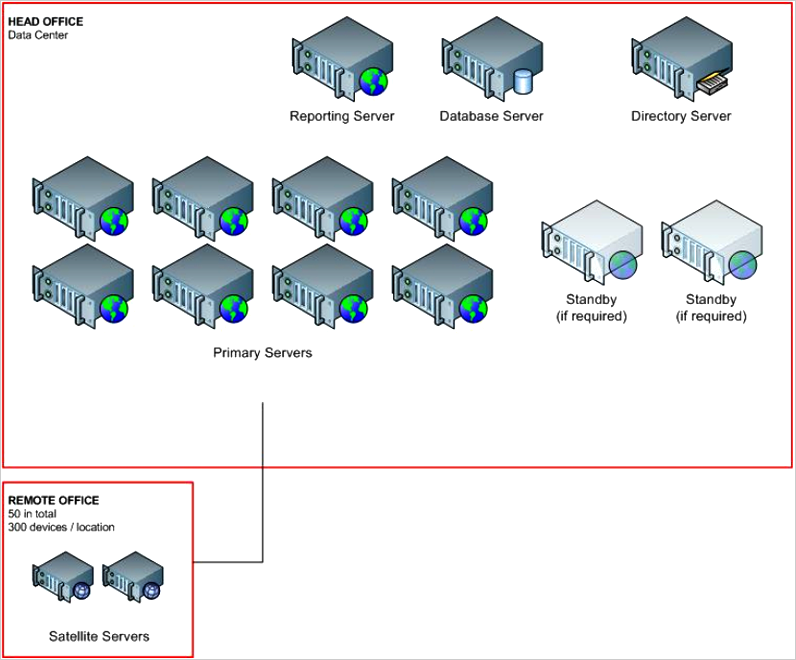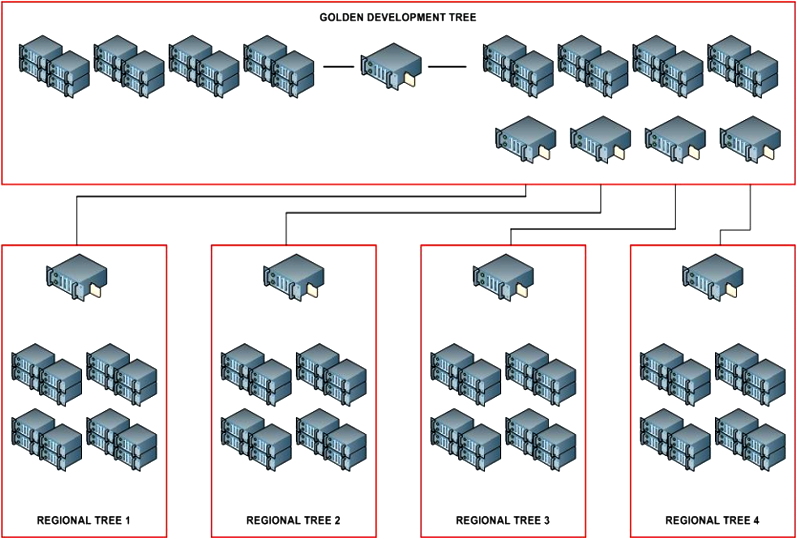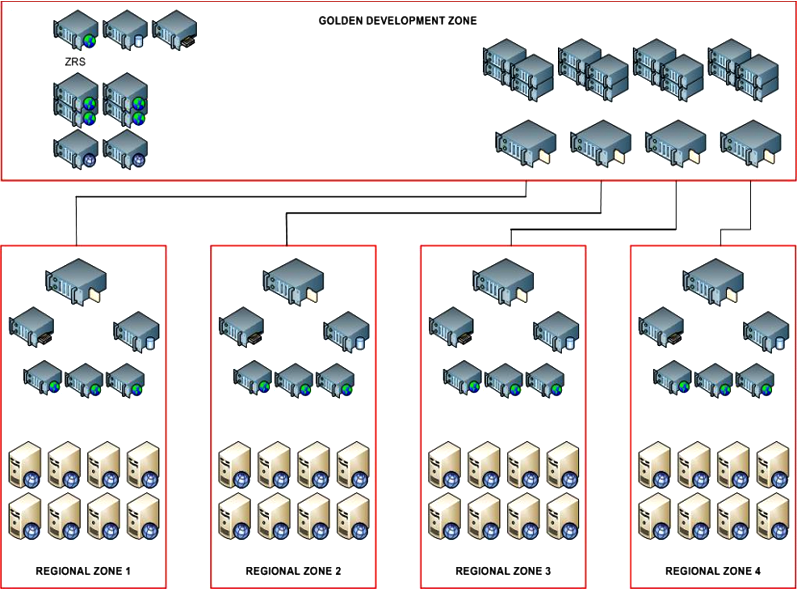5.5 Deployment Rules of Thumb
The following scenarios depict the rules of thumb to be followed for deploying ZENworks 11:
5.5.1 Scenario 1: One Major Location with 1, 500 Devices
Consider a scenario consisting of only one major location with 1,500 devices. To deploy ZENworks Configuration Management in this scenario, you should consider two Primary Servers to provide fault tolerance and load balancing, and any of the supported databases. Even though the External Sybase database is sufficient for your requirements, you can choose Microsoft SQL Server or Oracle, especially if growth is a future consideration.
In this scenario, there is no need for Satellite servers or configured locations (unless you want to create locations based on departments, or floors, etc.) but you must carefully monitor the overall system performance and add Primary Servers, if necessary.
5.5.2 Scenario 2: One Major Location with Several Remote Locations and More Than 1,500 Devices
Consider a scenario consisting of one major location, several remote locations, and more than 1,500 devices. To deploy ZENworks Configuration Management in this scenario, you must consider the following:
-
A minimum of three Primary Servers. You must plan to initially deploy three Primary Servers to provide a robust core infrastructure. If necessary, you can scale it back at a later time.
-
Enterprise-ready database infrastructure, based on either Microsoft SQL Server or Oracle.
-
Satellite Servers deployed to remote sites. Based on the size of the sites and Satellite roles, you can host the Satellite services on server class or workstation class devices. If User Sources are used, it is recommended to enable and configure the Authentication Role at the Satellite Server and have the server point to a local replica or domain for user and group object information.
-
Configure and use Locations, then configure Closest Server Rules at the Locations level. This will allow you to be in full control of where devices will go to perform functions as they travel around your network (ie Roaming Users). Otherwise the only option you have is the Default Closest Server Rule, and that is simply not flexible enough for this scenario.
Now let's take it a step further and provide some additional details so we can formulate a design.
-
One (1) major datacenter location
-
Fifty (50) remote locations
-
25,000 devices require management - 10,000 at main office, and 300 at each remote location (on average)
-
Will use all functions of ZENworks including ZENworks Reporting Server
-
Everything will be virtualized including the Database Server
Based on what we've outlined as best practices, this means that the first of design elements would be:
-
The Database Server and all Primary Servers would be located in the major datacenter location.
-
The database would be either Microsoft SQL Server or Oracle. In this case we will choose Microsoft SQL Server 2008, and run the database in Microsoft SQL Server 2005 compatibility mode.
-
Based on the number of devices that require management, we would initially make a recommendation for 8 Primary Servers that will be part of the Closest Server Rules, and paired up with Satellite Servers.
-
A 9th Primary Server dedicated to running the ZENworks Reporting Server, and excluded from the Closest Server Rules.
-
Two (2) Satellite Server at each location is recommended to provide fault tolerance, and balancing of load (mainly imaging).
-
Satellite Servers paired with the 8 Primary Servers evenly (ie. 25 per Primary Server).
-
A Location set up and configured for each of the physical locations (50). Along with this, you need to define each location using Network Environments. When set up, you are ready to configure the Closest Server Rules for each Location.
There is a lot of additional thought that needs to go into building the design, but as you can see it is easy to start envisioning what the overall design will look like from an infrastructure perspective. Scalability and service placement are the most important aspects of the design, everything else is work that you can accomplish in the lab or by discussing the topic with your teams.
Now that we have put together some of the basics, let's see what it looks like in graphical format:

5.5.3 Scenario 3: ZENworks 7 Migration to ZENworks 11
This scenario looks at the process of moving from ZENworks 7 to ZENworks 11 Configuration Management.
Assume the following specifics:
-
One tree for the development of applications, policies, and images.
-
Four regional production trees.
-
ZENworks 7 Desktop Management across the entire organization.
-
ZENworks 7 Server Management (Tiered Electronic Distribution) is used to replicate content between the development tree and regional trees.
-
20,000 devices are being managed (5,000 devices per regional tree).
-
Each regional tree has a main datacenter and several remote locations. There are no remote locations with more than 200 devices that require management.
The following diagram shows the customer’s existing infrastructure:

Based on what we have outlined as best practices, this means that the first of design elements would be:
-
Five zones in total - One development zone, and four production (regional) zones.
-
The development zone would be configured to two testing facilities, which is accomplished by using folders for content, devices, and roles to restrict where administrators or testers can create or modify content.
-
Each regional tree would include the following:
-
One database server running Microsoft SQL Server 2008 in the 2005 compatibility mode.
-
Three Primary Servers at the main regional datacenter.
-
Two Satellite Servers at each of the remote offices to mainly provide fault tolerance.
-
-
Content is still synchronized from the datacenter to datacenter by using ZENworks 7 Server Management. When the content is replicated to the regional datacenter, it is imported manually into the zone by the local administration team. In the future, ZENworks 7 Server Management will be replaced by the ZENworks Configuration Management content share/subscribe software.
-
An eDirectory infrastructure will still be a part of this overall design, and the User Sources will be configured to point to the local replica servers, which include both Primary Servers and remote Satellite Servers.
According to these design decisions, the infrastructure for this customer looks similar to the following diagram. With all designs, minor adjustments might need to be done to ensure that the designs meet all of the requirements for all devices and locations. These changes can be worked out in the lab and documented accordingly.
